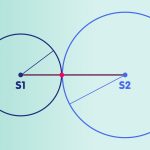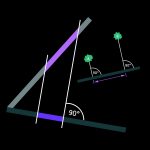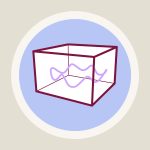How time is made
How the internationally valid coordinated universal time UTC is determined – and what role the theory of relativity plays in it
An article by Andreas Bauch
In science and technology, time is – as Einstein knew – relative: there is no generally valid definition of simultaneity in nature that can be derived solely from the laws of physics. And yet, in practice, it is very important to agree on a uniform time, at least by convention. For the synchronization of telecommunication networks, of energy supply and navigation systems, for example, certain processes and switching procedures at different places on Earth have to be concerted within millionths of a second!
By far the most important such convention determines how Universal Coordinated Time (UTC) is defined. UTC is the basis of time determination worldwide, for technical-scientific applications as well as in daily life. It is based on the cooperation between time institutes in the individual countries, the International Bureau of Weights and Measures BIPM (“Bureau International des Poids et Mesures”) and the IERS (“International Earth Rotation and Reference Systems Service”). How does this work in detail?
Desired properties of UTC
A world time has to meet high demands. Firstly, it should be reliably available to everyone everywhere without great effort. Secondly, it should have a high degree of stability: Each world time second should last as long as any other world time second – due to the limited accuracy of even the best clocks, this is certainly no trivial requirement. In addition, the world time seconds should, of course, be just as long as the second defined in the SI international system of units.
In other words, the clocks that are used to define world time should come as close as possible to an ideal clock – that would be a clock whose seconds correspond exactly to the seconds of the international system of units at any time.
On the other hand, UTC should allow to continue, at least approximately, the traditional measurement of time, which, as is well known, is derived from the rotation of the Earth and uses, for example, the average length of a day to determine the duration of an hour, minute or second (“mean solar time”). In exactly this tradition, the “time of day” is also continued: The counting of hours in UTC corresponds to mean solar time at zero longitude.
Reliability in a network
A single clock, no matter how good it may be in the general sense, cannot suffice as a basis for world time. For one thing, it could stop at any moment. For another, it is impossible to determine with a single clock how much its second length varies over time. This is only possible with a larger ensemble of clocks – there, one can estimate how much the individual clocks involved deviate from the ideal by comparing them with the mean value.
Accordingly, the backbone of world time is formed by a group of currently about 500 clocks that are distributed all over the world. They are operated by about 80 different institutions, ranging from national metrology institutes (such as the Physikalisch-Technische Bundesanstalt in Braunschweig) to institutions conducting research in the fields of aeronautics, astronomy, geodesy (such as the Wettzell Geodetic Observatory) or telecommunications. They use clocks which, due to their mode of operation, already promise the highest accuracy, namely the very most accurate atomic clocks: Cesium atomic clocks and hydrogen masers.
From the participating atomic clocks, time is derived according to a precisely specified procedure – a kind of “mean second” is obtained from the successive second ticks of the different clocks. For this purpose, each of the institutes chooses one of its clocks as a local reference and gives the sequence of second ticks emitted by it the designation UTC(X) – X stands for the institute name; the Physikalisch-Technische Bundesanstalt (PTB), for example, realizes a time UTC(PTB) in this way. With the help of radio signals, these different time scales are compared, so that the time differences between them are known with an uncertainty of a few billionths of a second. (How time can be transferred from one place to another for comparison purposes is described in the spotlight topic Time determination with radio signals – from radio-controlled clocks to satellite navigation). These comparisons have a relatively simple structure: The BIPM evaluates the collected measured values of all institutes in comparison with the PTB. This has not always been the case and does not have to remain this way. The choice of the “pivot” fell on the PTB years ago, because it is geographically conveniently located and allows to form a bridge between the continents; it generates a very stable time scale UTC(PTB) and has all the technical facilities for time comparisons.
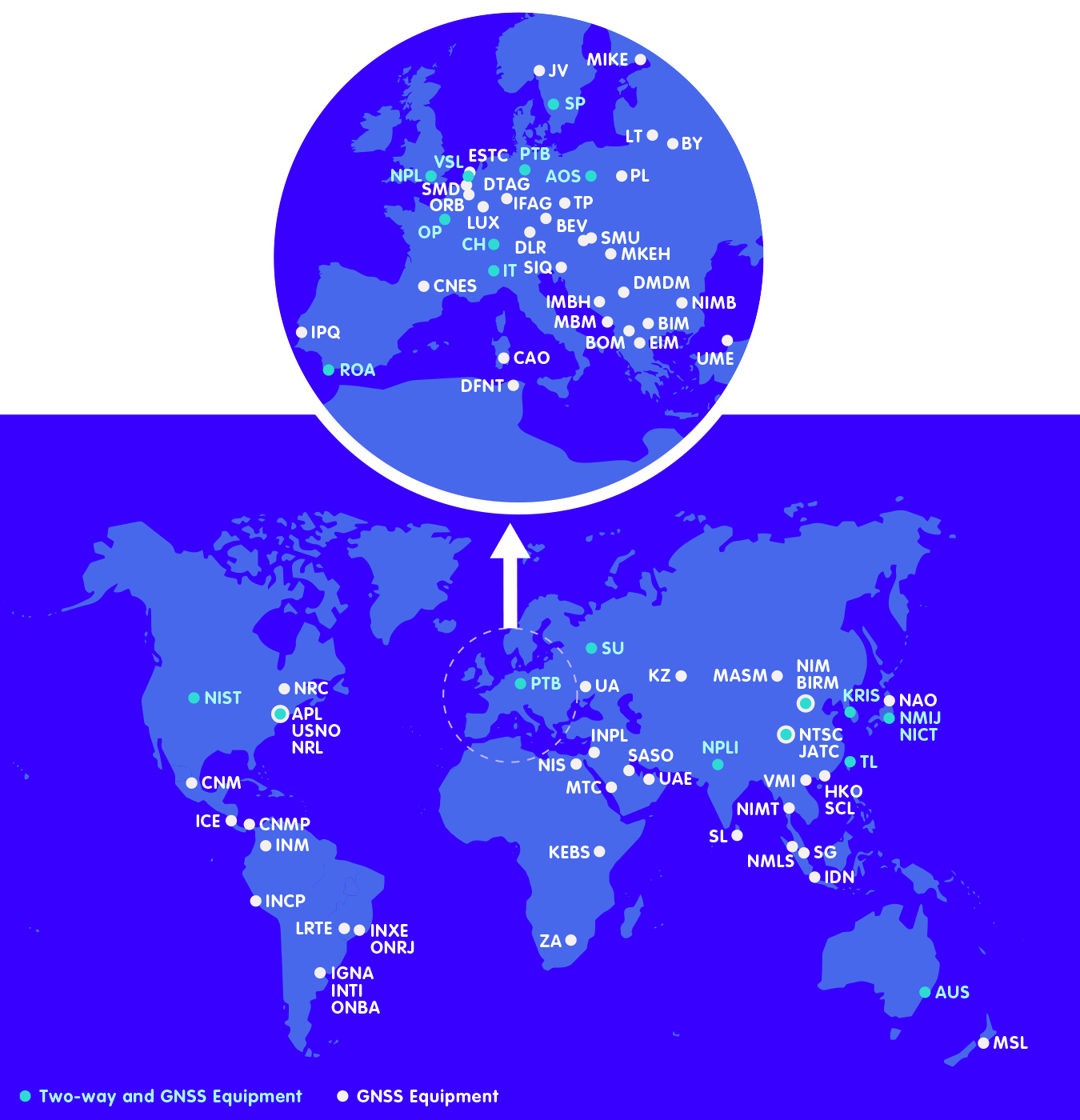
The figure shows the distribution of the world’s time institutes. Institutes marked in white are compared with PTB via signals of the satellite navigation systems GPS, to a lesser extent GLONASS and Galileo. Institutes marked in green operate additional facilities for time comparison by means of radio signals which are sent back and forth between the institutes by exactly the same type of satellite as is used for television transmissions.
All of these comparisons are made around the clock and the results are sent to the BIPM on a daily basis. In addition, each institute X transmits the time difference between UTC(X) and the state of the other clocks operated there. For small institutes, this may involve only one other clock; other institutes have the luxury of owning ten, twenty, or even more atomic clocks. In the first days of each month, the BIPM calculates a time scale called EAL (for “Echelle atomique libre”, roughly: free atomic clock time) from the readings collected during the previous month. In the determining equation for EAL, lengths of a second of all participating clocks from the previous month are included with different weighting. The weighting of a clock is determined by its behavior during the twelve preceding months. The less a clock’s rate fluctuates from month to month during this period, the greater is its weighting.
The comparison of the clocks with each other reveals their quality of the clocks, which are combined in the formation of UTC. Their rate typically deviates from that of an ideal clock by less than 50 billionths of a second per day – in other words, the time interval within which one of these clocks counts down the 86,400 seconds of a day is at most 50 billionths of a second longer or shorter than 86,400 seconds counted down with an ideal clock. By comparison, a typical quartz watch, the type we wear on our wrists, is off by about a tenth of a second per day, making it about two million times less accurate! Moreover, what’s really important is that the rates of these atomic clocks are comparatively stable: They change by less than 2 to 3 billionths of a second per day. Clocks with worse properties – of course, there are thousands of them – are not even involved in official timekeeping.
Back to the SI second
The calculation method for EAL ensures reliability and stability of this time scale: clocks whose rate varies as little as possible from month to month contribute more to the time scale; the distribution over many clocks on (almost) all continents ensures that the time scale does not change even if individual clocks should fail. However, this still does not guarantee that the seconds of the calculated time EAL correspond to the SI seconds. In fact, when averaging, at least in this respect, it is true that many cooks spoil the broth: Averaging over a large number of clocks is statistically robust, but it will not automatically result in an ideal time scale with SI seconds.
The remedy is a handful of so-called primary clocks built to actually provide SI seconds within an uncertainty specified by the operators. The figure below shows a photo composite of PTB’s four so-called primary clocks.
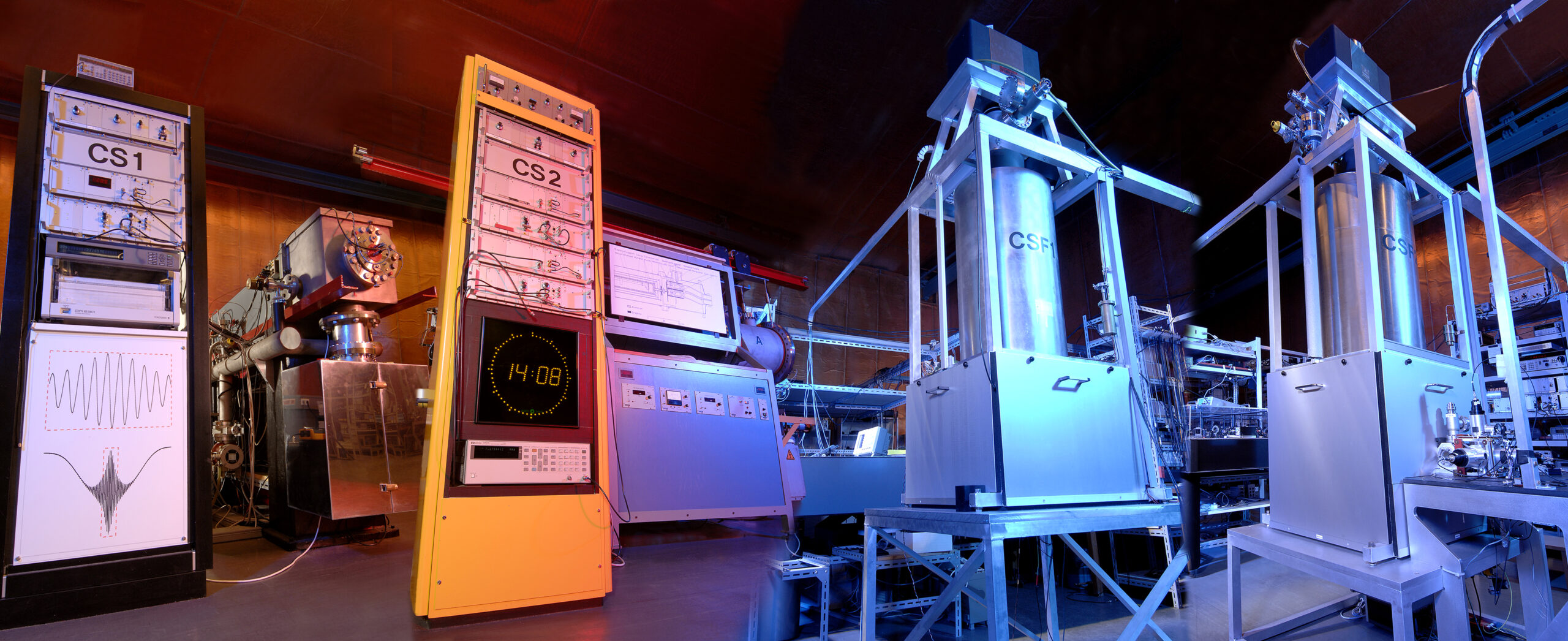
Image: PTB
The primary clocks CS1 and CS2 (left) were constructed in the late 1960s and mid-1980s, respectively, and are globally the only clocks of their generation that are still in operation. By design, they are superior to commercially available clocks, and until the end of the 20th century, they represented the best approximation of an ideal clock. Since 1996, there have been primary clocks with laser-cooled atoms that are (currently) even more accurate by a factor of one hundred. With CSF1 (cesium fountain one) and CSF2 (right), such novel atomic clocks have also been operated at PTB since 2001 and 2009, respectively.
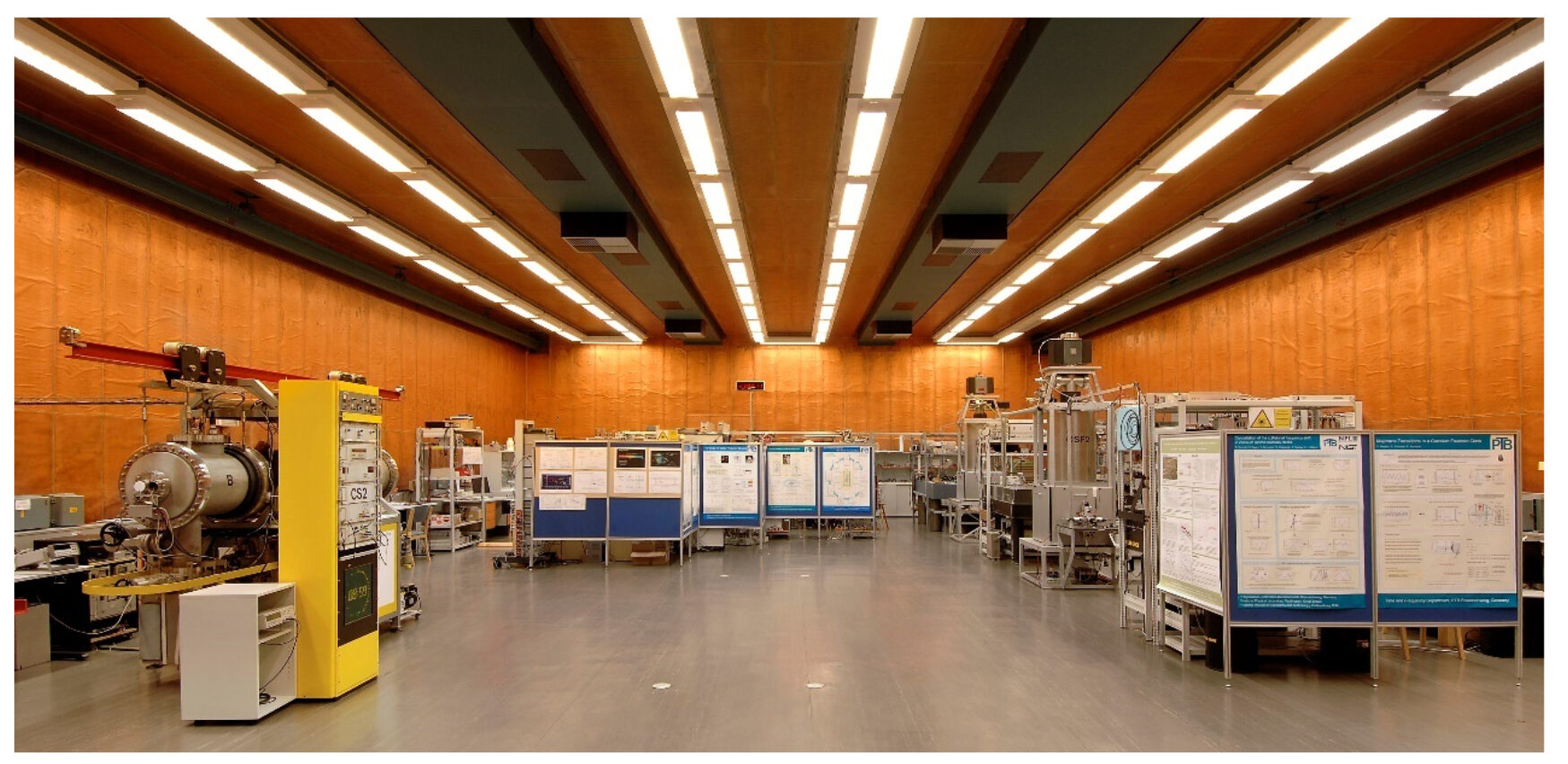
Image: PTB
Many visitors are impressed by PTB’s atomic clock hall, and the place is unique in the world indeed. In addition to the previously presented “classical” atomic clocks, the latest generation of clocks, so-called optical clocks, is being built in the background. With these clocks, an accuracy 100 times higher than with the caesium fountain clocks can be achieved.
Caesium fountain clocks are currently operated by ten institutes. This is still too few to calculate a stable, reliable averaged time from primary clocks alone, especially since they do not really work continuously. Their complexity requires occasional adjustments of lasers and mirrors and other manual interventions by scientists. Instead, the time differences of these primary clocks to the “ordinary” clocks of the same institute are measured and published more or less regularly. The BIPM corrects the course of the time EAL averaged over many clocks by means of such measured values. The time scale thus obtained is called International Atomic Time TAI (from Temps atomique international). It combines the advantages of the large clock network of the EAL (reliability and stability) and the primary clocks (faithful reproduction of the SI second).
These corrections are made only in tiny steps so as not to affect the stability of the time scale. Therefore, there remains a time-varying deviation between the second measure of the TAI and the SI second, which, however, has rarely been larger than a few trillionths of a part per thousand in recent years (written as a power of ten: 10-15 s).
At this point we note: As a result of these operations, the timekeeping of each of the contributing 500 clocks relative to TAI is known and published by the BIPM. Each of the 80 contributing institutes thus has access to the quality of super-accurate clocks without the need to develop and operate such equipment locally. The following image further illustrates the interaction of the various contributors.
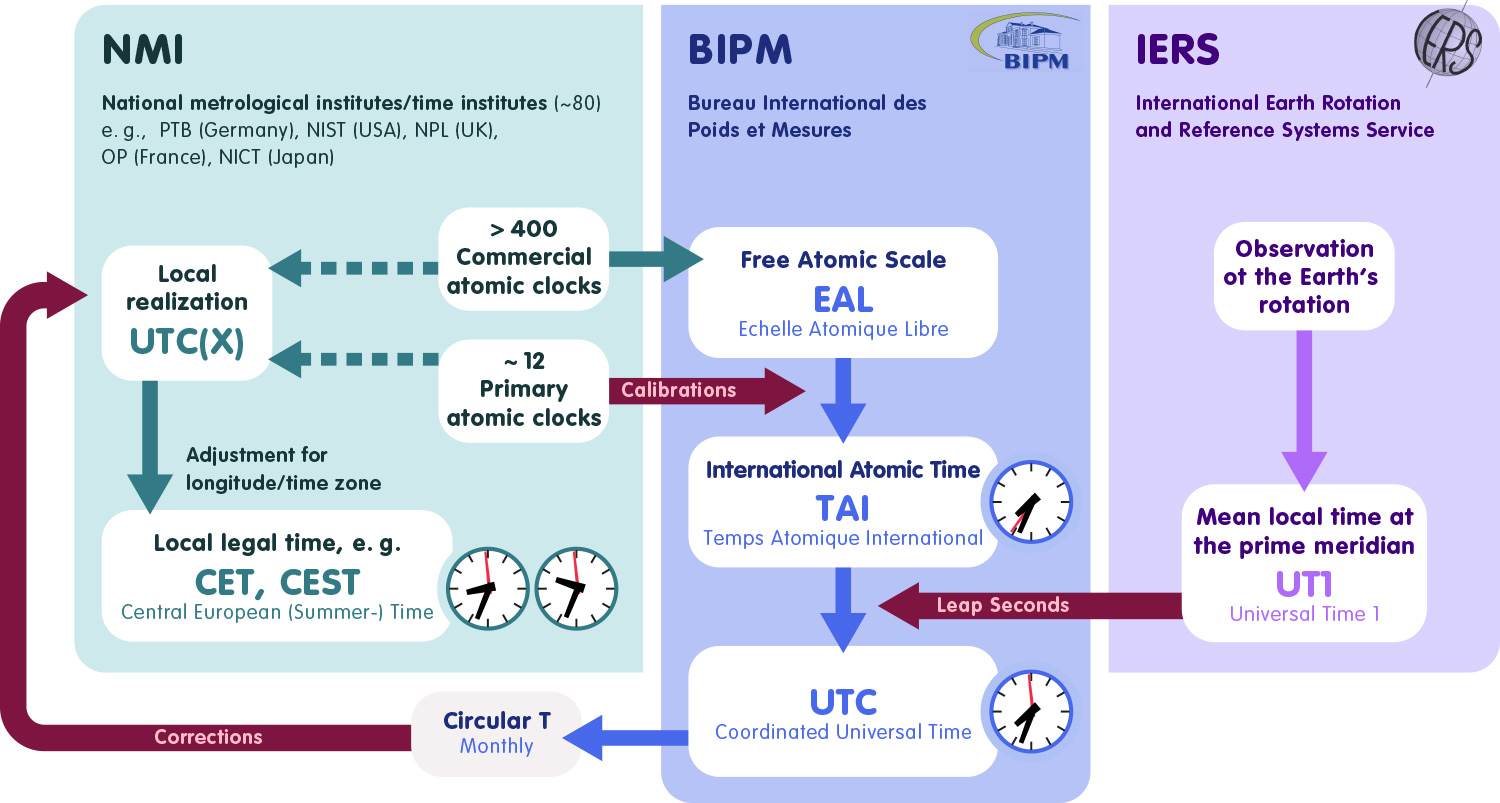
Now finally, it is time to shed light on the relativistic aspect of time determination, which plays an important role in the clock comparisons mentioned above.
Relativity and time coordinates
“It might seem that all difficulties concerning the definition of ‘time’ could be overcome by putting in place of ‘time’ the ‘position of the small hand of my clock’. Such a definition is indeed sufficient, if it is a question of defining a time exclusively at the place, at which the clock currently is; the definition is not sufficient any more, however, as soon as it is a question of linking series of events, which take place at different places, with each other in time, or – which amounts to the same – to evaluate events in time, which happen in places distant from the clock”.
Albert Einstein wrote this in the essay “On the Electrodynamics of Moving Bodies”, which laid the foundations of the Special Theory of Relativity. With modern language, we call the “time” described therein – the one that is valid only directly at the place of the clock – the proper time of that clock. The definition of the second in the international system of units does, rightfully, not take the theory of relativity into account: It defines the “proper time second”, and every ideal clock – as defined above – realizes SI seconds in its proper time, independent of its state of motion and its position.
From this, one has to distinguish the time as the fourth coordinate of a spatio-temporal reference system, which must always be defined if one wants to make time indications spanning all locations. The world time represents such a time coordinate, and more generally, such a coordinate plays a role whenever time measurements of clocks in different places are to be compared. According to the special and general relativity theory the result of such comparisons of two identical clocks depends on the one hand on the relative state of motion (special-relativistic time dilation), on the other hand on the gravitational potential prevailing at the place of installation (gravitational time dilation). Accordingly, one must consider the installation conditions of real clocks when comparing them.
Since comparisons play a crucial role in the determination of EAL and TAI, and since the desired accuracy is extremely high, one must appropriately take relativity into account. For gravitational time dilation, for example, general relativity predicts that a clock will speed up by about 0.01 billionth of a second per day if it is elevated one meter in the Earth’s gravitational potential. If one compares (for example with the help of radio signals) two ideal clocks, one at the PTB in Braunschweig at a height of h = 80 meters above sea level and one at the American institute NIST in Boulder/Colorado at a height of h = 1697 meters, then the clock in Boulder would be ahead by 14.792 billionths of a second per day compared to the clock in Braunschweig. Without knowledge of the theory of relativity, it would be hard to decide which of the two clocks is to be called ideal.
For the determination of the time coordinate TAI, one has therefore chosen a spatial reference surface, namely the geoid, a kind of mean surface of the oceans covering the earth and the usual reference point for indications of the “height above sea level”. The geoid is a useful reference surface because it can be shown that the equilibrium condition from which the position of the water level results (from the point of view of an observer rotating with the Earth: gravitational and centrifugal forces balance each other) simultaneously ensures that the sum of the relativistic time dilation effects (time dilation due to motion caused by the Earth’s rotation plus time dilation due to the gravitational field) has the same value for all clocks located directly on the geoid.
The second as would be measured by a clock directly on the geoid is determined to be the second of time coordinate TAI. Operators of primary atomic clocks therefore determine the height h of their primary clocks above the geoid and apply an appropriate frequency correction when the readings are transmitted to control TAI. TAI thus becomes a coordinate time and its time unit is defined by very specific clocks. It represents a realization of the so-called “Temps Terrestriel”, the Earth time in the rotating reference system.
From the atomic second to coordinated universal time
Beginning with the Washington Conference of 1884, mean solar time at zero longitude (Greenwich Mean Time) served as the reference for the international time system for decades. In simple terms, solar time is defined by the length of the day – a day’s length is the time interval between two successive peaks of the sun in the sky, i.e. between two successive mid-days. To define mean solar time, the average of day lengths is taken over an entire year. Astronomers later refined this definition and called it UT1 (for “Universal Time 1”).
However, it turned out that the period of the Earth’s rotation is not constant and that, on top of the deceleration due to the interaction between the Earth and the Moon, it is subject to far larger periodic and also irregular fluctuations. Every definition of the second derived directly from the Earth’s rotation, would lead to sometimes a bit longer, sometimes shorter seconds – an unacceptable situation for physical measurements as well as for technical applications. This is not the place for going into the history of the definition of a second. In any case, the atomic second valid today is defined in such a way that the TAI of the atomic clocks deviates more and more from the Earth’s rotation time: The middays defined by TAI – 12:00 o’clock – shift on average more and more with respect to the highest position of the sun.
The coordinated universal time UTC is a compromise. UTC and TAI have the same scale – one second UTC is exactly as long as one second TAI. However, extra seconds are inserted into UTC at certain intervals, called leap seconds, just enough to limit the difference between UTC and solar time UT1 to less than 0.9 seconds. The leap seconds cause a UTC day to occasionally have one more than the usual 86,400 seconds. But anyone counting UTC seconds (or their fractions) to measure time intervals can be confident that each second is reliably as long as the one following it.
The result of this definition of UTC can be seen in the following figure. It shows on the one hand the difference between TAI and the Earth rotation oriented time UT1, on the other hand as a step curve the difference between TAI and the Coordinated Universal Time UTC:
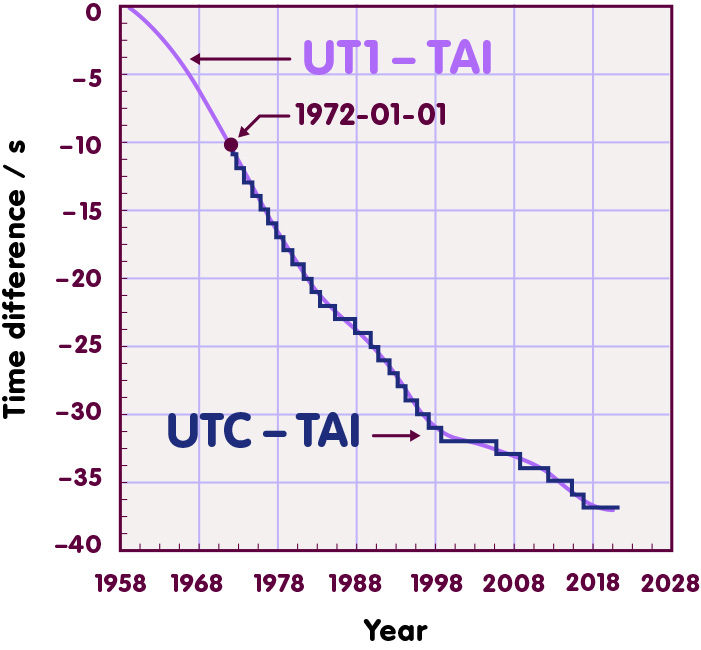
It can be seen that over the years shown, the atomic second was on average about 19 billionths of a second (37.2 seconds in 62 years) shorter than the averaged world time second. In 2004, 2005, and 2020, for example, there were days when the Earth rotated once around its axis in less than 86,400 atomic seconds! The introduction of the leap seconds happens at the turn of the year or also in the middle of the year as the last second of December 31st or June 30th in UTC. The decision about this is made by the International Earth Rotation and Reference Systems Service depending on the observed period of the Earth rotation. The irregular introduction of leap seconds (corresponding to the unequal spacing of the steps in the figure above) reflects the uneven rotational speed of the Earth.
UTC is the basis of our present world time system with 24 time zones. It is published in the form of calculated offsets from the time scales UTC(X) realized in the single time institutes X. This explains the requirement that these scales UTC(X) should agree as well as possible with UTC – and thus also with each other. How successful this is, is exemplarily illustrated by the following picture.
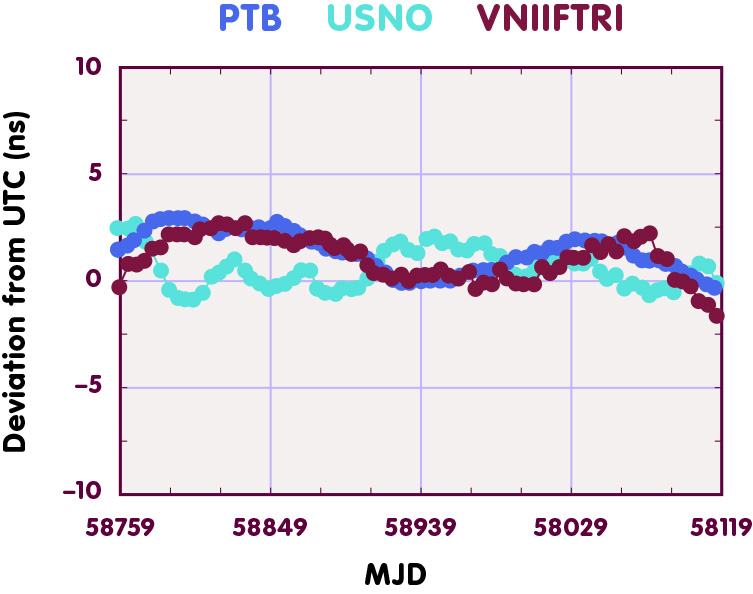
The figure shows the deviation between the time scales of PTB (blue), the US-American USNO (cyan) and the Russian institute VNIIFTRI (red, traditionally designated UTC(SU)) during one year. MJD denotes the Modified Julian Date, 59119 corresponds to September 27, 2020. Why this choice? UTC(USNO) and UTC(SU) serve as time reference for the transmission of signals of the satellite navigation systems GPS and GLONASS, respectively. UTC(PTB) is one of the five time references for the European system Galileo (see also the spotlight topic: Relativity and Satellite Navigation). UTC(PTB) is also the basis of the legal time in Germany and is broadcast as such via the long wave transmitter DCF77 (see the spotlight topic Time determination with radio signals – from radio-controlled clocks to satellite navigation). As another example, also in France, UTC is the basis of legal time, whereas England has not yet made this leap into modern times. There, according to the law, “solar time”, the famous Greenwich Mean Time, is still valid, but in practice, of course, atomic time is also used.
Further Information
The question of how time can be transmitted from one place to another is dealt with in the spotlight topic Time Determination with Radio Signals – from Radio-controlled Clocks to Satellite Navigation, already mentioned in the text. The basic relativistic concepts underlying this spotlight are explained in Elementary Einstein, especially in the sections Special Relativity and General Relativity.
Related spotlight topics on Einstein-Online can be found in the categories General Relativity and Special Relativity.
Further information on time determination can be found on the PTB website, also on the web pages of the Bureau International des Poids et Mesures (BIPM) on international atomic time, and the web pages of the International Earth Rotation and Reference Systems Service (IERS), which watches over the introduction of leap seconds.
Colophon
is head of the “Dissemination of Time” working group at the Physikalisch-Technische Bundesanstalt in Braunschweig.
Citation
Cite this article as:
Andreas Bauch, “How time is made” in: Einstein Online Band 13 (2021), 1008



